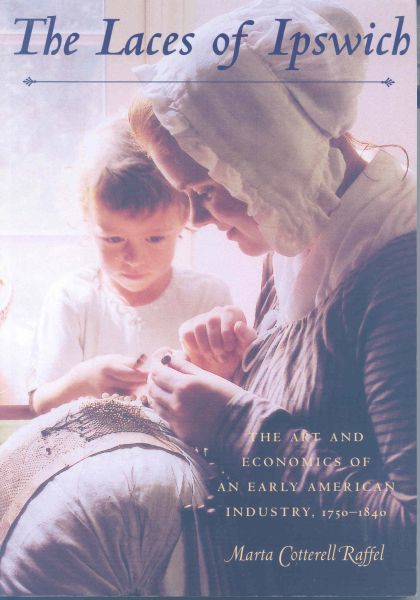The Laces of Ipswich: The Art and Economics of an Early American Industry, 1750-1840

Genre
- Bobbin Lace
- History
Subject
- History, Identification, Fashion
- Ipswich Lace
- Lace And Lace Making - Massachusetts
Plot
In its lace making heyday in the late eighteenth century, Ipswich, Massachusetts boasted 600 lace makers in a town of only 601 households. George Washington himself, a lace afficionado, paid a visit to Ipswich in 1789 to support its extraordinary domestic textile industry. While most research on lace making concentrates on its cottage origins in the seventeenth century, Marta Cotterell Raffel places the Ipswich industry squarely within the wider context of eighteenth-century manufacture, economics, and culture. Identifying what differentiates Ipswich lace from other American or European lace, she explores how lace makers learned their skills, and how they combined a traditional lace making education with attention to market-driven changes in style. Showing how the shawls, bonnets, and capes created by the lace makers often designated the social position or political affiliation of the wearer, she offers a unique and fascinating guide to our material past. With extensive research based on hundreds of previously unseen artifacts and documents, Raffel shows how this preindustrial labor and craft—absolutely central to the economic health of Ipswich—created and sustained forms of early American culture and shaped an entire community for several generations. Useful appendixes include a glossary of terms; a list of contemporary sources for supplies, lace organizations, and textile museums with lace collections; and two sample patterns with pricking and instructions.
Personal
| Owner | NELG |
|---|---|
| Location | Box 10 |
| Read | |
| Index | 147 |
| Added Date | Apr 10, 2012 16:56:40 |
| Modified Date | Mar 10, 2025 15:01:45 |
Value
| Book Condition | Good |
|---|
Notes
History of the lace industry in Ipswich MA.
A second copy of this book, donated by the Ipswich Museum, is part of the mobile exhibit kit that MEM has.


 English
English  Nederlands
Nederlands  Deutsch
Deutsch  Français
Français  Español
Español  Magyar
Magyar  српски
српски  Dansk
Dansk  Italiano
Italiano  Svenska
Svenska  Slovenčina
Slovenčina  Português
Português 
